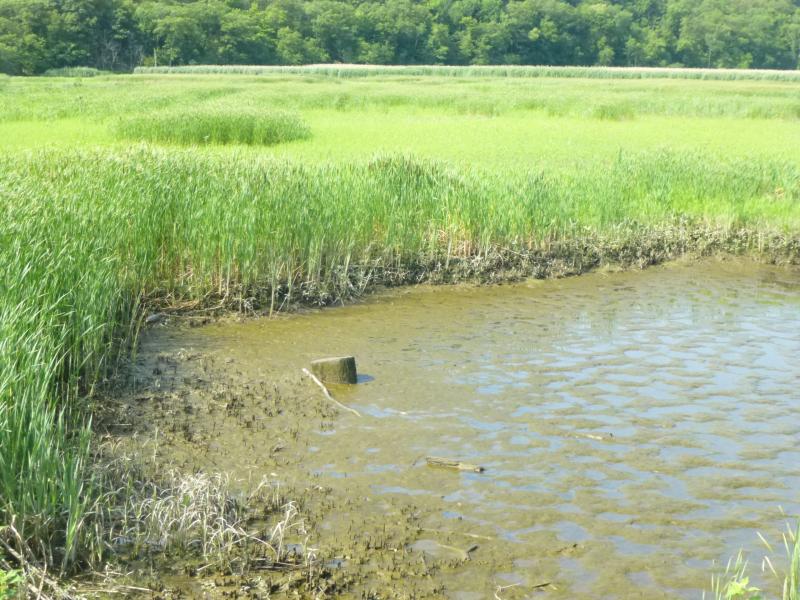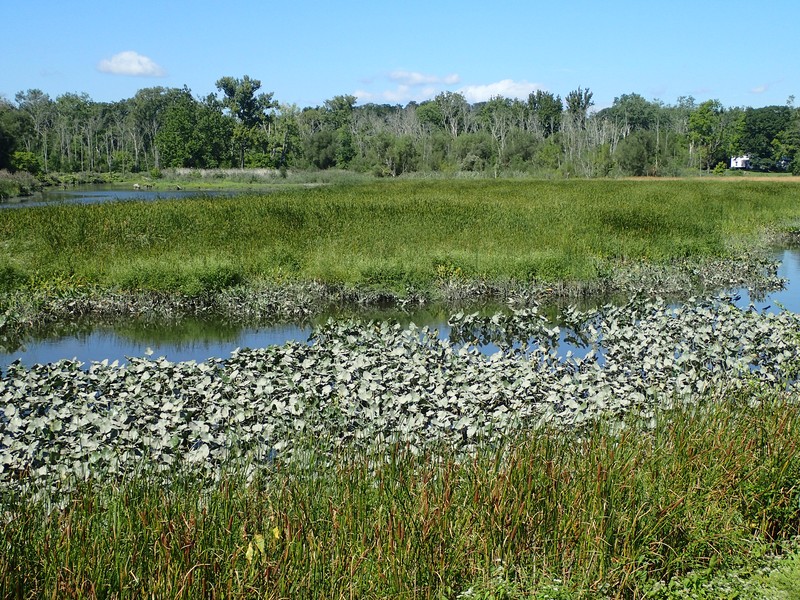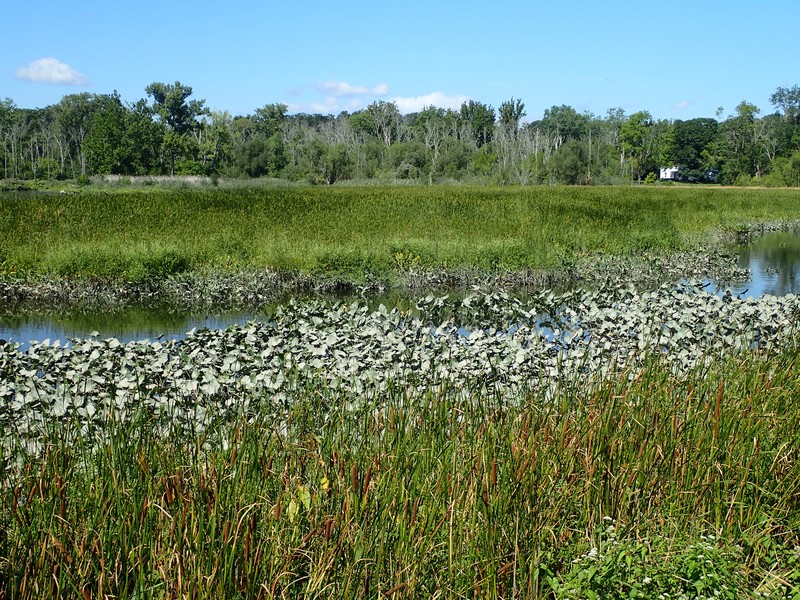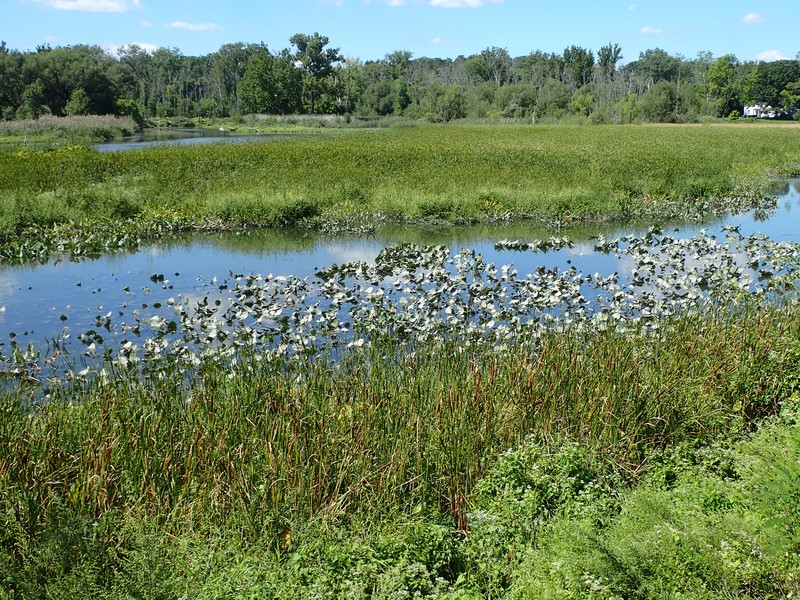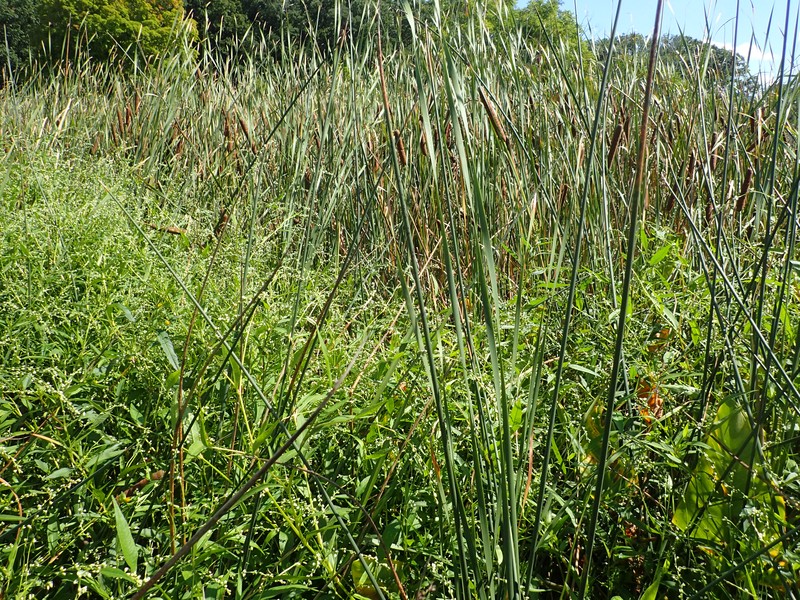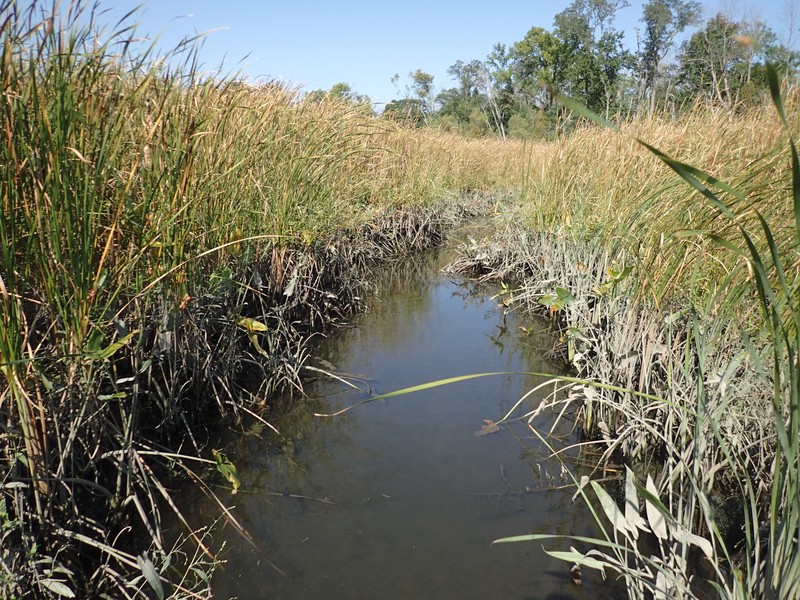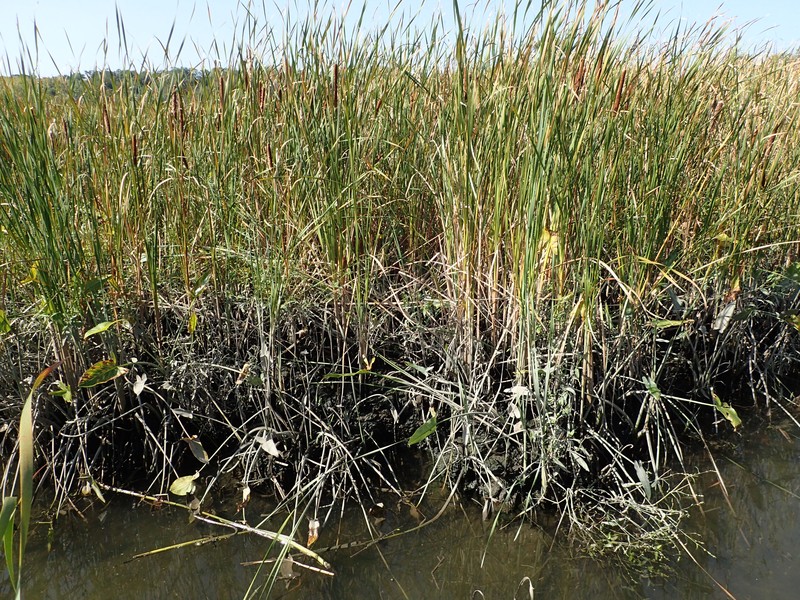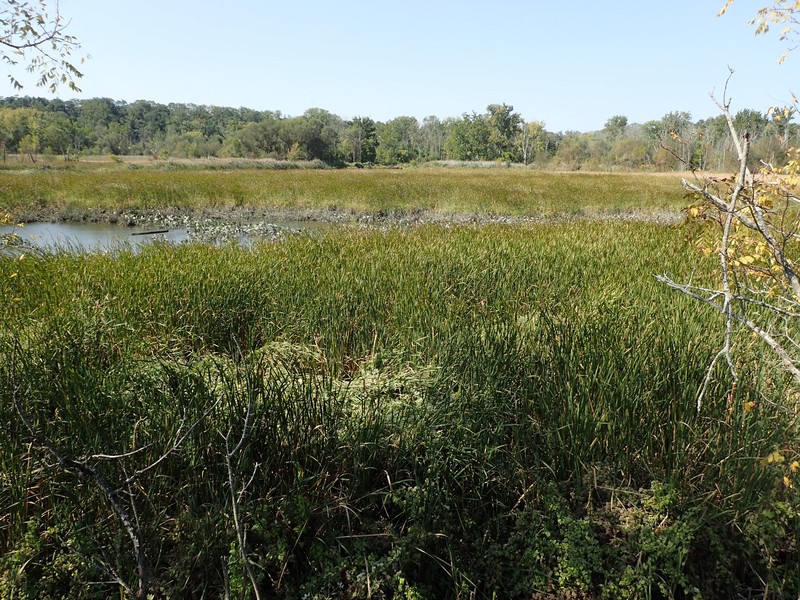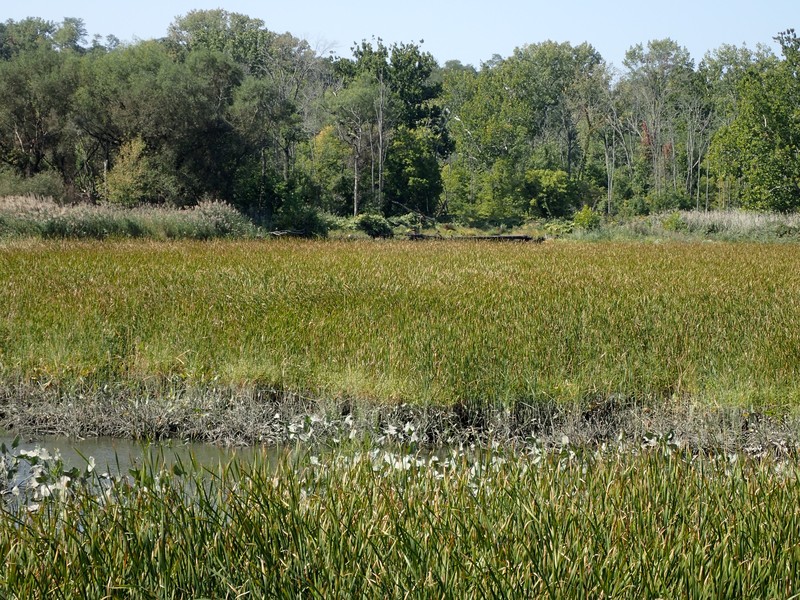Brackish Tidal Marsh
- System
- Estuarine
- Subsystem
- Estuarine Intertidal
- State Protection
- Not Listed
Not listed or protected by New York State.
- Federal Protection
- Not Listed
- State Conservation Status Rank
- S1
Critically Imperiled in New York - Especially vulnerable to disappearing from New York due to extreme rarity or other factors; typically 5 or fewer populations or locations in New York, very few individuals, very restricted range, very few remaining acres (or miles of stream), and/or very steep declines.
- Global Conservation Status Rank
- G4
Apparently Secure globally - Uncommon in the world but not rare; usually widespread, but may be rare in some parts of its range; possibly some cause for long-term concern due to declines or other factors.
Summary
Did you know?
Brackish tidal marshes are river-associated estuarine environments found upstream from salt marshes. The water salinity values of brackish tidal marshes change frequently due to the tidal influence. Salinities may be similar to freshwater tidal marshes (around .05% or less) at low tide, and similar to the ocean (3% or more) during the highest tide. The species composition of brackish tidal marshes is a combination of species characteristic of salt and freshwater tidal marshes due to this factor. Areas with the highest water salinity values are the least diverse.
State Ranking Justification
There are probably less than a dozen occurrences statewide. A few documented occurrences have good viability and a few are protected on public land or private conservation land. This community is restricted to brackish portions of estuaries in the state, and includes a few moderately sized, good quality examples. The current trend of this community is probably declining slightly due to moderate threats that include alteration of the natural hydrology and invasive species. Reed grass (Phragmites australis ssp. australis) appears to be a particular threat to this community.
Short-term Trends
The number of brackish tidal marshes in New York have probably remained stable in recent decades due to wetland protectection regulations. However, the condition and size of a few occurrences may have declined due to invasive species, such as purple loosestrife and reed grass.
Long-term Trends
The number of brackish tidal marshes in New York has probably declined substantially from historical numbers as a result of shoreline development (e.g., railroads) and river channel dredging.
Conservation and Management
Threats
The main threats to this community are shoreline development (e.g., railroad tracks that impede or alter tidal flow) and invasion of exotic species, such as reed grass (Phragmites australis ssp. australis), purple loosestrife (Lythrum salicaria), and Japanese knotweed (Reynoutria japonica var. japonica). Reed grass appears to be a particular threat to this community. A lesser threat is chemical run-off from railroad maintenance or accidental spill. Dredging of shipping lanes may also pose a threat by reducing water quality, or decreasing area due to deposition of dredge spoils.
Conservation Strategies and Management Practices
Maintain the natural tidal regime in marshes that have been cut off from the Hudson River by the railroad tracks. Control and remove invasive exotic species, such as purple loosestrife and especially reed grass.
Development and Mitigation Considerations
Strive to minimize or eliminate hardened shorelines and maintain low-sloped shorelines within the tidal zone. Maintain functional connectivity between the river and bays with marshes to enable full tidal flushing during each tidal cycle. For example, barriers such as railway causeways should have numerous culverts to allow sufficient hydrologic connectivity.
Inventory Needs
Review tidal marsh maps and data collected by partner organizations and incorporate this information into the New York Natural Heritage database. Resurvey and update occurrences with records greater than 10 years old.
Research Needs
Research the effects of invasive exotic plants on brackish tidal marshes.
Rare Species
- Agalinis maritima var. maritima (Seaside Agalinis) (guide)
- Ardea herodias (Great Blue Heron) (guide)
- Atriplex dioica (Thick-leaved Orach) (guide)
- Bidens laevis (Smooth Beggar Ticks) (guide)
- Bolboschoenus maritimus ssp. paludosus (American Saltmarsh Bulrush) (guide)
- Bolboschoenus novae-angliae (New England Bulrush) (guide)
- Callitriche terrestris (Terrestrial Water Starwort) (guide)
- Cardamine longii (Long's Bittercress) (guide)
- Carex hormathodes (Marsh Straw Sedge) (guide)
- Circus hudsonius (Northern Harrier) (guide)
- Elatine americana (American Waterwort) (guide)
- Eleocharis uniglumis (Single-glumed Spike Rush) (guide)
- Eriocaulon parkeri (Estuary Hatpins) (guide)
- Eupatorium torreyanum (Torrey's Thoroughwort) (guide)
- Ischnura ramburii (Rambur's Forktail) (guide)
- Ixobrychus exilis (Least Bittern) (guide)
- Kinosternon subrubrum (Eastern Mud Turtle) (guide)
- Libellula needhami (Needham's Skimmer) (guide)
- Lilaeopsis chinensis (Eastern Grasswort) (guide)
- Lithobates kauffeldi (Atlantic Coast Leopard Frog) (guide)
- Potentilla anserina ssp. pacifica (Coastal Silverweed) (guide)
- Rumex fueginus (American Golden Dock) (guide)
- Sagittaria montevidensis ssp. spongiosa (Spongy-leaved Arrowhead) (guide)
- Suaeda rolandii (Roland's Seablite) (guide)
- Symphyotrichum subulatum var. subulatum (Annual Saltmarsh Aster) (guide)
- Tripsacum dactyloides (Northern Gama Grass) (guide)
- Tyto alba (Barn Owl) (guide)
Range
New York State Distribution
The range of this community primarily corresponds to the brackish tidal range of the Hudson River (i.e., from between New Hamburg/Poughkeepsie downstream about 25 miles to Hastings-on-Hudson). It also occurs within the brackish tidal range of the smaller tidal rivers of Long Island (e.g., Carmans and Nissequogue rivers).
Global Distribution
This community occurs along the Atlantic coast from Maine to Virginia and possibly to South Carolina.
Best Places to See
- Bear Mountain State Park (Rockland County)
- Hudson Highlands State Park (Putnam County)
- Tallman Mountain State Park (Rockland County)
- Wertheim National Wildlife Refuge (Suffolk County)
Identification Comments
General Description
Brackish tidal marsh communities occur where water salinity levels are between 0.5 to 18 parts per thousand (ppt) and water is less than 2 m (6 feet) at high tide. The vegetation is very dense, dominated by graminoid species, and is made up of a mix of salt marsh and freshwater tidal marsh species. Characteristic species include narrowleaf cattail (Typha angustifolia), crimsoneyed rose mallow (Hibiscus moscheutos), seaside goldenrod (Solidago sempervirens), saltmarsh fleabane (Pluchea odorata), and various bulrushes (Schoenoplectus spp., Bolboschoenus spp.). Brackish tidal marshes that are dominated by reedgrass (Phragmites australis ssp. australis) as a result of anthropogenic disturbance are classified as cultural communities (e.g., estuarine impoundment mash, estuarine dredge spoil). Brackish marshes that have had the tidal influence restricted may be classified as a palustrine cultural community, such as reedgrass/purple loosestrife marsh.
Characters Most Useful for Identification
A brackish marsh community made up of a mix of salt marsh and freshwater tidal marsh species dominated by tall graminoids. Water salinity values range from 0.5 to 18 ppt and water depth is less than 2 m (6 feet).
Best Time to See
A variety of showy wildflowers bloom in brackish tidal marshes throughout the summer, including crimsoneyed rose mallow (Hibiscus moscheutos), seaside goldenrod (Solidago sempervirens), and saltmarsh fleabane (Pluchea odorata).
Brackish Tidal Marsh Images
Classification
International Vegetation Classification Associations
This New York natural community encompasses all or part of the concept of the following International Vegetation Classification (IVC) natural community associations. These are often described at finer resolution than New York's natural communities. The IVC is developed and maintained by NatureServe.
- Switchgrass - Saltmeadow Cordgrass - Beach Sedge Salt Marsh (CEGL006150)
- Narrowleaf Cattail - Crimson-Eyed Rosemallow Tidal Marsh (CEGL004201)
NatureServe Ecological Systems
This New York natural community falls into the following ecological system(s). Ecological systems are often described at a coarser resolution than New York's natural communities and tend to represent clusters of associations found in similar environments. The ecological systems project is developed and maintained by NatureServe.
- Atlantic Coastal Plain Northern Salt Pond Marsh (CES203.892)
- Northern Atlantic Coastal Plain Tidal Salt Marsh (CES203.519)
Characteristic Species
-
Vines
- Calystegia sepium (hedge bindweed)
-
Emergent aquatics
- Amaranthus cannabinus (salt marsh water-hemp)
- Bolboschoenus
- Bolboschoenus fluviatilis (river bulrush)
- Bolboschoenus novae-angliae (New England bulrush)
- Bolboschoenus robustus (sea-coast bulrush)
- Eleocharis parvula (salt-loving spike-rush)
- Hibiscus moscheutos ssp. moscheutos (swamp rose-mallow)
- Impatiens capensis (spotted jewelweed, spotted touch-me-not)
- Iris pseudacorus (yellow iris)
- Lilaeopsis chinensis (eastern grasswort)
- Nuphar advena ssp. advena (intertidal yellow pond-lily, intertidal spatter-dock)
- Peltandra virginica (green arrow-arum, tuckahoe)
- Persicaria punctata (dotted smartweed)
- Pilea sp.
- Pluchea odorata (salt marsh-fleabane)
- Pontederia cordata (pickerelweed)
- Sagittaria latifolia (common arrowhead)
- Schoenoplectus americanus (chair-maker's bulrush)
- Schoenoplectus tabernaemontani (soft-stemmed bulrush)
- Solidago sempervirens (northern seaside goldenrod)
- Thelypteris palustris var. pubescens (marsh fern)
- Typha angustifolia (narrow-leaved cat-tail)
- Zizania aquatica var. aquatica (southern wild-rice)
Similar Ecological Communities
- Brackish intertidal mudflats
(guide)
Brackish tidal marshes and brackish intertidal mudflats are often adjacent to each other, or can form a patchy mosaic within an embayment or creek mouth. Both communities are influenced by diurnal tides and often have similar muddy substrates. However, brackish intertidal mudflats are sparsely vegetated by low-growing rosette leaved aquatics (e.g., Sagittaria montevidensis ssp. spongiosa, Sagittaria subulata), compared to brackish tidal marshes that are typically dominated by narrow-leaved cattail (Typha angustifolia).
- Freshwater tidal marsh
(guide)
Freshwater tidal marshes have lower salinity values than brackish tidal marshes, and feature species that are intolerable to brackish water, such as spatterdock (Nuphar advena), sweetflag (Acorus americanus), and blueflag (Iris versicolor). Freshwater tidal communities are located upstream from brackish tidal communities.
- High salt marsh
(guide)
High salt marshes have vegetation that is more characteristic of higher pore water salinity values, such as spikegrass (Distichlis spicata), black-grass (Juncus gerardii), and sea-lavendar (Limonium carolinianum). Species characteristic of freshwater wetlands are absent from high salt marsh communities, or are restricted to the extreme edges where pore water salinity levels drop. Salt marshes are located downstream from brackish marshes.
- Low salt marsh
(guide)
Low salt marshes have higher water salinity values than brackish tidal marsh communities, are more heavily influenced by tides, and are typically dominated by the tall form of saltwater cordgrass (Spartina alterniflora). Other halophytes, such glassworts (Salicornia spp.) and seablites (Suaeda spp.) may be present as well. Species characteristic of freshwater marshes are completely absent from low salt marsh communities. Salt marshes are located downstream from brackish marshes.
- Shallow emergent marsh
(guide)
Brackish tidal marshes and shallow emergent marshes may share some of the same plant species, but shallow emergent marshes are strictly non-tidal.
Vegetation
Percent cover
This figure helps visualize the structure and "look" or "feel" of a typical Brackish Tidal Marsh. Each bar represents the amount of "coverage" for all the species growing at that height. Because layers overlap (shrubs may grow under trees, for example), the shaded regions can add up to more than 100%.
Additional Resources
References
Edinger, G. J., D. J. Evans, S. Gebauer, T. G. Howard, D. M. Hunt, and A. M. Olivero (editors). 2014. Ecological Communities of New York State. Second Edition. A revised and expanded edition of Carol Reschke’s Ecological Communities of New York State. New York Natural Heritage Program, New York State Department of Environmental Conservation, Albany, NY. https://www.nynhp.org/ecological-communities/
Edinger, Gregory J., D.J. Evans, Shane Gebauer, Timothy G. Howard, David M. Hunt, and Adele M. Olivero (editors). 2002. Ecological Communities of New York State. Second Edition. A revised and expanded edition of Carol Reschke's Ecological Communities of New York State. (Draft for review). New York Natural Heritage Program, New York State Department of Environmental Conservation. Albany, NY. 136 pp.
Kiviat, Erik and Gretchen Stevens. 2001. Biodiversity assessment manual for the Hudson River Estuary Corridor. New York State Department of Environmental Conservation. Albany, NY.
MacDonald, Dana and Gregory Edinger. 2000. Identification of reference wetlands on Long Island, New York. Final report prepared for the Environmental Protection Agency, Wetland Grant CD992436-01. New York Natural Heritage Program, New York State Department of Environmental Conservation. Latham, NY. 106 pp. plus appendices.
Metzler, K. and R. Rosza. 1982. Vegetation of fresh and brackish tidal marshes in Connecticut. Newsletter of the Connecticut Botanical Society 10(1): 1-3.
Muenscher, W.C. 1937. VII. Aquatic vegetation of the Lower Hudson area. 1936. Biological Survey. 11:231-248.
New York Natural Heritage Program. 2024. New York Natural Heritage Program Databases. Albany, NY.
Reschke, Carol. 1990. Ecological communities of New York State. New York Natural Heritage Program, New York State Department of Environmental Conservation. Latham, NY. 96 pp. plus xi.
Links
About This Guide
Information for this guide was last updated on: December 13, 2023
Please cite this page as:
New York Natural Heritage Program. 2024.
Online Conservation Guide for
Brackish tidal marsh.
Available from: https://guides.nynhp.org/brackish-tidal-marsh/.
Accessed July 27, 2024.

